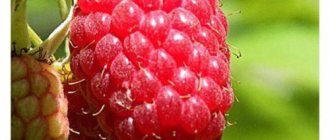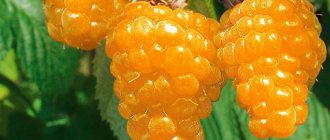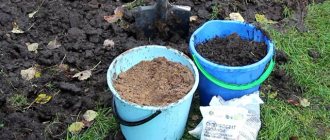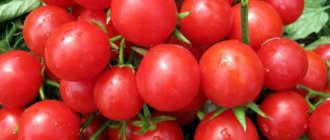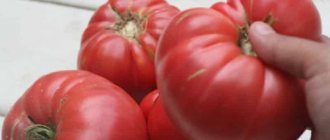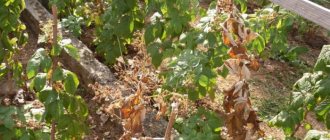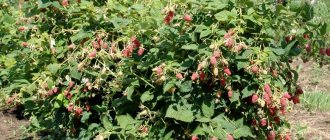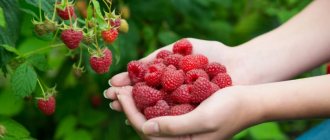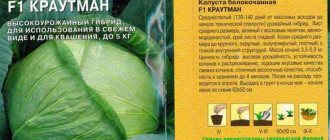Description of the raspberry variety Tatyana
A breeding variety of raspberries was created for cultivation in the southern region, the temperate climate of the European and Central Black Earth parts of Russia. The tall crop reaches two meters. The bush produces about 12 shoots, which form a compact crown. Unlike remontant species, raspberries “Tatyana” bear fruit only on stems of the second year of growth. And it does not require radical pruning at the root. The level and duration of fruiting is the same as for species that produce two harvests per season.
External characteristics of the raspberry variety “Tatyana”:
- One-year-old stems are dark brown, thick, with a dense elastic structure, growing upright.
- Young shoots are light green; by the end of the season the color changes to dark red.
- The thorniness of the shrub is completely absent, there is no hairiness, only a waxy coating clearly visible on the trunks and shoots.
- The leaves are small in size, with a corrugated surface. Sparse pile is present on the lower part. The edge of the leaf is carved with frequent teeth, dark green.
- The flowers are small, cream-colored, density on one fruit cluster is up to 8 pieces, self-pollinating, 100% produce ovaries.
- The root system is branched, superficial, requiring shelter for the winter.
Attention!
Raspberries are tall, fixation to a trellis is recommended. Description of the raspberry fruit "Tatyana":
- the fruits are well attached to the stalk, at the stage of biological ripeness the berries do not fall off and are easily removed when harvesting;
- the weight of one raspberry is 15–25 g, the pulp is dense, juicy, there are few seeds, they are small in size and cannot be felt when eaten;
- the surface of the berry is uneven with densely spaced drupes, bright red in color, with slight hairiness;
- the fruits throughout the bush are the same size in the shape of a slightly elongated oval.
Large-fruited raspberries "Tatyana" have a balanced taste, with a minimal presence of acid and a pronounced raspberry aroma.
Raspberry Terentiy: variety description, care, photos, characteristics
Raspberry Terentiy is a non-remontant variety of modern Russian selection, but is still unfamiliar to amateur gardeners. Its main characteristics are large-fruited and standard type of bush. Terenty is a representative of the third generation of large-fruited raspberries and the second generation of standard forms (colloquially and in advertising called “raspberry trees”).
History of raspberries Terenty
In 1994, Professor V.V. Kichina carried out cross-pollination of two large-fruited second-generation raspberries - tall Patricia and standard Tarusa.
Among the resulting hybrid seedlings in 1997, an interesting standard-type form was identified. It received variety status and the name Terenty in 1998. The work was carried out at the Institute of Horticulture and Nursery Growing (Moscow).
Characteristics of the variety
Sweet berry with a light aroma.
- The height of plants does not exceed one and a half meters even on the most fertile and moist lands. Most often, the bushes are even lower - about 120 cm. They look very powerful. The shoots grow straight and bend to the side only under the weight of the crop. Fruiting bushes still need low supports.
- The foliage is corrugated, dark green. The leaf blades are large, pointed at the tips.
- Replacement shoots of an adult bush grow in sufficient quantity - 8–10 stems each.
- Root shoots are weakly formed near young plants. Over the years it becomes more numerous - about 5 pieces near each bush. Enough for reproduction.
- The stems are very strong, thick, strong. They don't bend. The tops of the shoots do not bend, as is usually the case with other raspberries. It is interesting that the thickness of the trunk is almost the same in the upper and lower parts, the narrowing towards the top is very slight.
- The surface of the shoots has no thorns at all and is absolutely smooth from top to bottom. This is a fundamental feature of almost all Kichino large-fruited varieties (with the exception of the prickly Mirage and Yellow Giant). This property makes it possible to distinguish truly large varieties from thorny fakes, even among seedlings on the market.
- The integumentary tissues have slight felt pubescence and a weak waxy coating.
- The color of the bark of young shoots is light green, light green. By autumn they become lignified and darken. Overwintered trunks are brown.
- The internodes of the Terenty variety are closely related to each other. The buds are located very densely. In the second year, long fruiting branches (laterals) grow from each axil. Each stem becomes like a branched tree.
- Laterals (fruit branches) are located on the stem from top to bottom, appearing even from the lowest buds.
They are thornless, thick and durable, and do not require additional garter. The brushes are very powerful, triple and quadruple branched. They bear two to three dozen ovaries. The photo allows you to see this varietal feature in all its glory. "Terenty" has very strong and thick stems that can bend only under the weight of a bountiful harvest.
Berries
The size of the Terenty raspberry berries ranges from 4–10 grams, on the lower branches – up to 12–15 grams. The spread in weight greatly depends on the level of agricultural technology and the microclimate of the site.
- The shape of the fruit is elongated, with a conical slope, and blunt at the bottom. The fruit is large, so the collected berries have a very large cavity inside and are easily crushed.
- The color is bright crimson, with a slight shine.
- The drupes are quite large. They are interconnected to a moderate degree. There are many seeds and they are medium in size.
- The taste of unripe berries is bland, but when fully ripe it is sweet. The smell is light. Like other large-fruited varieties, the berries are colored first and gain sweetness later. You should not pick and taste unripe berries - they have not yet acquired a typical taste.
- The pulp is very tender, melting. Tasty, but not at all transportable. All large-fruited varieties suffer from this, but Terenty is more guilty than others. It is good to eat the berries directly from the bush. In damp weather and when left on the bush, the fruits become limp and may become moldy.
Ripening time
Fruit ripening in Terenty raspberries begins in the mid-early period. In the Moscow region, this is the beginning of the second ten days of July. The main fruiting lasts 3–4 weeks; individual berries appear before September.
Productivity
The number and size of berries of Terenty raspberries greatly depends on the growing conditions.
The amount of harvest from the Terenty variety very much depends on the climate of the region, the microclimate of a particular garden plot, the level of agricultural technology and wintering conditions.
The average (approximate) yield is 4–5 kg per bush. With a comfortable climate and increased nutrition, fees can be doubled. This is quite a feasible task.
Resistance to diseases
Compared to the “mother” variety Tarusa, Terenty raspberry is much less susceptible to attack by viral and fungal diseases.
This was the purpose of selective selection. Tarusa, as a hybrid of the previous generation, is more susceptible to some viruses (for example, mosaic), as well as to fungal infections of stems (anthracnose, purple spot). Terenty's plants are much healthier. But it is still necessary to protect it from fungal pathogens.
Problems with wintering
It is recommended not to just bend standard raspberries for the winter, but to hide them in a well-ventilated shelter.
Unfortunately, standard large-fruited raspberries are not particularly winter-hardy. This is the main obstacle to their triumphal march through the gardens of our country.
They are also not very comfortable in hot climates. There they winter more successfully, but in the summer they suffer from heat and dryness. They prefer a cool climate, but harsh winters frighten them.
Malina Terenty is no exception. If late autumn or early spring has little snow, then even the roots of standard raspberries may freeze, resulting in complete death of the bush. At negative temperatures below thirty degrees, those shoots that rise above the snow level will certainly freeze.
Even bent stems do not always overwinter successfully. And it’s not easy to bring them closer to the ground - the standard trunks are too thick. You have to bend them down quite early, at the very beginning of autumn, before they become woody. It is advisable to hill the plants with the first snow that falls. Some gardeners not only bend standard raspberries like Terentia for the winter, but also cover them. Only the shelter must be dry (as for roses, grapes), otherwise there is a risk of the stems dying from overheating.
Top dressing
Raspberry feeding calendar.
If a lot of snow accumulates on the site, you can try to grow Terentia without bending down for the winter. But both the very first frosts and spring thaws can become dangerous.
For standard raspberries, it is difficult to maintain a balance between good ripening of shoots and increased nutrition for the crop. Sufficiently watered and fed raspberry bushes bear fruit more abundantly, but their shoots become lignified worse, and this reduces winter hardiness. Therefore, for Terenty raspberries, you need to strictly follow the feeding regime: nitrogen in the first half of summer and phosphorus-potassium in the second.
Planting and care
Terenty raspberries, like any standard raspberries, are best planted using the bush method.
- The plantation cannot be placed on lands where groundwater is close and there are spring floods. The cold, swampy lowland is no place for Terenty. High embankment ridges will not save you - the roots will freeze.
- It is better to plant standard large-fruited raspberries of the Terenty variety not in autumn, but in early spring.
- Plants are placed in a bush manner. The optimal distance between bushes is one and a half meters.
- Large-fruited raspberries require increased nitrogen nutrition in the spring and in June-July. The soil in the root zone should always be moderately moist.
- Agricultural practices such as mulching, autumn bending of shoots, and standard treatments against diseases and pests are required.
During the fruiting period, the raspberry stems of this variety are fixed on a low support.
Large-fruited raspberries: stages of selection
The fruits of wild raspberries and traditional varieties are not large in size.
Berries weighing 3–6 grams are considered large. Only at the end of the 20th century did fundamentally new varieties with super-large fruits (4–12 grams or more) appear. The first such forms were discovered on a raspberry plantation in the British Isles. They were considered the result of a genetic mutation. Now there is an opinion that it was a spontaneous hybrid of raspberries and blackberries. Scientists began to conduct further crossings.
- Russian (Soviet) breeder V.V. Kichina brought seeds of similar hybrid raspberries to our country from Scotland (Great Britain). The very first sowing (1976) made it possible to obtain and select interesting forms with incredibly large fruits. This is how the first generation of large-fruited varieties appeared: Maroseyka, Stolichnaya, Mirage and some others.
- Next, scientists began to pollinate these forms among themselves and with other varieties. The 80s were marked by the selection of the second generation: Patricia, Tarusa, Stoleshnik, Krasa Rossii.
- The third generation received (in the 90s) genes from the previous ones with the addition of “blood” of new hybrids from Scotland. The Pride of Russia, Terenty, and Anfisa were born.
The second and third generation hybrids were selected for berry quality, disease resistance and other valuable factors.
Standard raspberry: the truth about the “raspberry tree”
Standard raspberry varieties are distinguished by straight, thick stems and an abundance of fruit branches.
The main goal of breeding was to breed large-fruited and productive raspberries. The work included mutant forms with close internodes and thick stems. This is how standard-type raspberry hybrids appeared: short, strong, with densely located buds. The very first and most famous of them is the Tarusa variety (1990).
This miracle was popularly dubbed the “raspberry tree” for its upright thick stems and abundance of long fruit branches. Naturally, these are not trees. From a distance, they look more like currant bushes - low and dense.
conclusions
Today, the “raspberry tree” is mentioned with or without reason, especially for advertising purposes. It has become a fashion brand. But serious raspberry growers prefer the more correct term “standard raspberries”.
Video about growing standard raspberries using the Sobolev method
frukti-yagodi.ru
Characteristics of the variety
The raspberry variety “Tatyana” fully corresponds to the description of the copyright holders. During the process of experimental cultivation, the breeders corrected the shortcomings. Raspberries received good immunity against diseases from their parent varieties. The level of fruiting is not affected by negative weather conditions.
Drought resistance, frost resistance
For photosynthesis, raspberries need a sufficient amount of ultraviolet light. Therefore, place the crop in a sunny area. The more lightening, the larger and sweeter the berry will be. According to gardeners, raspberries “Tatyana” exhibit average drought resistance. If there is no moisture for a long time, the plant may die.
The Tatyana variety is frost-resistant and was created for cultivation in temperate climates. Subject to frost protection measures, raspberries can be grown in risky farming areas. The root system tolerates temperatures down to –27 0 C; damaged fragments are quickly restored in the spring. If the weather conditions of the region are characterized by a drop in temperature below the norm established for raspberries, it is recommended to cover the root circle.
Productivity and fruiting
Raspberry "Tatyana" is a mid-season variety. A crop with a long growing season. The berries ripen unevenly, fruiting continues from the end of June to August inclusive. The fruits are collected in several stages; this feature of raspberries has become the reason for being classified as a remontant species. One bush produces up to 10 kg of berries per 1 sq. m there are 2 plants.
The gastronomic characteristics of the fruit are high, there is no acid in the taste, the berry is juicy and aromatic.
Advice! It is not recommended to pick Tatyana raspberries in the morning or in the rain, when the berries are wet. Such raspberries do not store well and lose their shape and juice.
Area of application of fruits
Raspberry berries of the Tatyana variety are universal in use. Due to its ability to retain its marketable appearance after harvest, the crop is cultivated on farm plots for commercial purposes and the food industry. Raspberries are well transported in special boxes at a certain temperature (+40 C). Home-grown berries are used to prepare compote, juice, jam, preserves. Consumed fresh. Retains taste and energy value after freezing.
Resistance to diseases and pests
The third generation raspberry hybrid has a genetically inherent ability to resist a number of fungal and bacterial infections. The variety is not afraid of: anthracosis, leaf mosaic, bacterial canker. It has high immunity against aphids. Possibly raspberry stem gall midge.
Advantages and disadvantages of the variety
Reviews about the raspberry variety "Tatyana" are different. Against the background of most of the positive qualities, there are disadvantages. For full vegetation and fruiting, a sufficient amount of ultraviolet radiation is necessary. Fixation to a trellis is recommended. The root system produces a small number of shoots, which makes raspberry propagation difficult.
The advantages of the Tatyana raspberry variety include:
- long fruiting period;
- resistance to direct sunlight;
- can do without watering for some time;
- large-fruited variety, yield;
- absence of thorns;
- sweet taste, increased juiciness of berries;
- resistance to diseases and a number of pests;
- good transportability and safety;
- lack of tendency to fruit shedding;
- frost resistance;
- compactness of bushes.
Suitable for breeding in farm areas and summer cottages.
Landing Features
The raspberry variety “Tatyana” is usually propagated by seedlings purchased in the retail chain. You can prepare planting material yourself. To obtain the desired harvest, it is necessary to comply with agricultural technology for this type of crop.
Recommended timing
Raspberries "Tatyana" are planted on the site in spring or autumn. For early planting, seedlings with an open root system are suitable. The work is carried out depending on the climate of the region. The earth should warm up to at least +50 C. For the Middle Zone this is approximately mid-April. In autumn, seedlings are planted 14 days before the onset of frost, approximately the end of October. The seedlings are used with the root closed and the raspberries are insulated for the winter.
Choosing a suitable location
The raspberry variety is demanding on lighting, so choose an area in the open, on the south side. It is necessary to place the raspberries in such a way that they are not influenced by the north wind. The plant does not require systematic watering. If the site is located in a lowland with close groundwater, raspberries slow down the growing season and produce smaller fruits. The variety prefers well-drained loam or black soil.
Selection and preparation of planting material
They purchase raspberry planting material from nurseries or prepare seedlings themselves. To grow Tatyana raspberries, you must select material that meets the following criteria:
- thickness of the central shoot 1.5 cm;
- roots are developed, without damaged fragments, 25 cm long;
- Two shoots should extend from the root system.
Seedlings for propagation are suitable for one year and two years, with a closed and open root system.
Landing algorithm
Before placing raspberry seedlings in a permanent place, the area is dug up and weeds are removed. Add fertilizing: organic matter, potassium, phosphate. Sequencing:
- Dig a planting hole measuring 40x40 cm, up to 30 cm deep.
- Compost mixed with peat is placed at the bottom.
- The seedling is placed in the center, the roots are distributed.
- Cover the plant so that the root collar remains on the surface.
- Water generously with warm water.
The plant is compact, the distance between rows should be 1.5 m. Raspberries are distributed in one line with an interval of 0.5 m.
Forum statistics
208686 Messages in 1636 Topics from 5641 Users. Last user: Cerberus Last message: “Rooting wine cuttings...” ( Today at 06:57:45) Latest messages on the forum.
Now on the forum
45 Guests, 15 Users
Users in the last 15 minutes: Marina Protasova, Vova Kapran, Volgar, Belgorodets, VeraNiK, yotmast, Realist, Andrey 31, Liza, dralexk1, Ivan Levin, Alex65, Zavezen Oleg Ivanovich, Evgen, boltik [Blocked] [Section Moderator] [Moderator Forum]
Maximum online today: 112 . All-time maximum online: 2758 (28 July 2021, 17:22:51)
Users who visited the forum in the last 24 hours
Total: 324
(Visible: 323, Hidden: 1) 1963, Marina Protasova, Vova Kapran, Volgar, Belgorodets, VeraNiK, yotmast, Realist, Andrey 31, Liza, dralexk1, Ivan Levin, Oleg Ivanovich Zavezen, Alex65, Evgen, boltik, Inna161, Snezhinets , freesia, Grandfather Igor, Elena Aleshchenko, Elena Z, Vitaly Kholkin, Lyuda5, Timofey, Antrikan, Alexander Sh, Svetlana Korotina, Evgeniy 50, Quiet, kvg, Dmitry Anatolyevich, Ilya 77, Evgeniy30, thanatos, Mikhail Alekseevich, leonidych, zsb , Oleg56, 25nata35, ElenkaF, Linx, vladimirM, GALINA ANOKHINA, G.V, Alexey V, Casperzrq, Elvira2017, Alexander Vl., Natasha, DIL, Lyubov S., YurSanych, Capricorn, Nikolai Mikhailovich, Alexander K, vlad51, Evgeniy 163, Evgen_Ev, Tatyana Provorova, Skif, Victor B, Nikolay Lipunov, sergei, Evgeniy52, 77volt, hanter64, Tatyana B, kosmos, slavalimon, Mikhail77, skier, rivaN, y_fed, Kazak, Igor Sergeevich, Victor55, Andrey15, OlgaOs, Dorontsov Peter , Chapai, Buba, Mikhno Alexander, alexsandr, Amber7394, SANYCH, Pioneer, DimaRostov, Dmitry 77, Verona, DED2, MaxL, nicson7, Vasily V., Kenig, Alexander Taganrog, VitalySD, Dmitry-Kozadoev, Alexey Deminov, Elektronik_t, Galinka , DSW, Agryzkov Alexey, Taker, Kadyrov, bonami, antar, Sergey 1965, Andrey Gladilin, SvetlanaBondareva, tolya, Nadezhda Grig, Naumov Igor, Igor F., Pavel 64, Roman Fedorovich, igor222, max2008-01, Iv Iv, Vika , Andrey Lis, lomakin1969, linalenadavi, gheo55, Sergey Chistokletov, mystic69, Grinya, Cherkessk, Andrey76, Serzh1978, Haus, , Vladimir-kanevskaya, Iglika, Morgana, Igor K, Tatyana Rogacheva, Ekaterina Polyanina, Yuri _Saransk, Sergey 61 , Armagnac , Alexander48, tsv, Verbitsky E.I., Lyudmila, Victoria Aleksandrovna, Vladimir Berdnikov, and.drew, Maximilian, Denisovich, Soshnin Yura, Sasha57, Natalia Nikolaevna, Gaivoronsky Yuri, weather forecaster, Lydia58, Vyacheslav03, Sa-shura, irahelm, Pitko, Volodya R, Volgogradka, Alexander71, Natalia1968, Valentina Ivanovna, L.A.P., dayton, marlin64, Tanyusha, Vasily1111, Yuri 14, Dmitry Nikolaevich, Oleg Filippov, Valery Rastorguev, Kalevanych, AlexsandrP, LeXa_KoT, Sergey Yuryev, cfibr, stenlly2010, rambo, maxbul, Nadymchanka, Eduard., nik2, serginio, potap05, nadia, Sergey Tashchiyan, Gardener - amateur, Alexander-ask-34, Vladimir Kostochkin, Wintel, Vyacheslav Vladimirovich, mers, Izhitsa, Ramiz, Akhmed, gardener, P7N, alexss, Zaur, TITOVA LYUBOV, Sergey Ko, Tatyana Volzh, Grandfather Young, pioneer-2, ketch, Bublichenko Alexander M, Ildar, Sergei Vasilevi4, Helga, Marshal, Vasily 53, Den, Alexander150, Yavgen3678, vikbublik, Valerie, Henry, Alexander_89, nick041, Svetlana Streletskaya, neposny, yak, Vladimir Buturlakin, Yagodka, Aprel, Antonk1983, PS-URA, spotlight, Nikolay S., Andrey68, Alexander565, Gennady163, AndSanych, Alexander Guy, kdm57, oleg9f, Badaev Dmitry, Yura, formula1, Cerberus, 64nikolay64, Yuri Semyonov, Kryn, N.A. Sokolov, TIS, Guram, sem_en, Alexander Smirnov, AlexanderD, Spikina Galina, Anatoly Sivkov, Alexey Sh., mira567, Mst, victor_, Vadim, Salex, Yuri P., Bison, Vardan, cecet71, Coltrane, Alexander 61, Andrey Beribesov, Efimych, Vladimir-27, Vovka, LOZA, ilja, Unter, Gela, Irinka, NatalyaMed, ichtiandr, Sergey Lomonosov, krasnovlad1, Irene, Pirko Alexander, Khramov, YATATYANA, , Mihalych., ni, Vladimir Kovba, Rita, nau_63, Yuri72, Lisav, niy1, NelyaS, MikhAf, Alexander Zinoviev, Zayac, SNovichek, Tatyana A., VDV, Dmitry-Ivanovich, Saisan, slaviking, court, Vladimir Shilov, Oleg Swedov, Sergey2017, Masha_sadovod, Burundukx, Lamo, Oleg A., arnyusha, Leonty Yarygin, Vyacheslav-56, lena, Igor 31, Sergey 31, Zhorzhovich, nut lover, Enych, turist, Ewgeniy, Ivan Shmelev , atseton
Aftercare
The raspberry variety “Tatyana” is not remontant and does not require special agricultural technology. Care for the plant in the following way:
- Watering is moderate until the berries ripen, then stop. Water after harvest.
- Weeding is carried out to remove weeds and enrich the roots with oxygen.
- Raspberries are pruned twice, last year's shoots are removed in the fall, dry fragments are cut off in the spring, and young stems are shortened.
- There is no need to completely cover the bush for the winter; to prevent freezing of the root system, mulch with sawdust, peat or humus.
- Raspberries are fertilized in the spring with potassium or phosphate fertilizers, after the growing season with organic matter.
To protect against rodents, products that are toxic to animals are laid out on the garden bed. For raspberries, it is recommended to install a support.
Care
As already mentioned, Tatyana is not a remontant raspberry, so you need to care for it like a regular variety.
Pruning and thinning
You need to prune non-repairing raspberries twice a year. In the fall, two-year-old shoots that bear fruit are cut out, and diseased and weak branches are removed.
In the spring, preventive pruning is carried out: frozen or dry branches are cut out, young shoots are trimmed a few centimeters.
It is recommended to thin out Tatiana’s dense bushes by cutting out excess shoots and shoots. If this is not done, the rows will become too dense, which will affect the quantity and quality of the berries.
More on the topic: Features of growing standard Mirage raspberries
Poor ventilation can lead to infection of the raspberry tree with infections, the appearance of slugs and other parasites.
Watering and mulching raspberries Tatyana
It is necessary to water raspberries, especially if the summer has been dry. Usually, watering is stopped after the berries have formed, and resumed immediately after the last harvest. The raspberries that have been “drunk” in the fall overwinter better.
To prevent the soil from drying out and cracking, it is advisable to use mulch. Sawdust, straw, peat, humus, and mown grass are suitable as a mulch layer for Tatyana.
Top dressing
In the spring, Tatyana raspberries are fed with mineral fertilizers, focusing on potassium and phosphorus, but in the fall it is also possible to use organic matter (mullein, bird droppings, humus, compost, wood ash).
Diseases and pests, methods of control and prevention
Infections on Tatyana raspberries are extremely rare; the variety has high immunity to infection. The insect that parasitizes crops is the stem gall midge. It affects the stems of the plant, convex formations form on them. The shoots dry out and die. The insect can destroy up to 80% of a raspberry bush.
To prevent the pest from spreading to subsequent bushes, damaged fragments are cut out and removed from the area. Raspberries are treated with a solution of Fufanon, Actellix, Alatar. For preventive purposes, the area is dug up in the fall, and the larvae freeze out in the winter. Remove old grass where fungal spores may remain.
